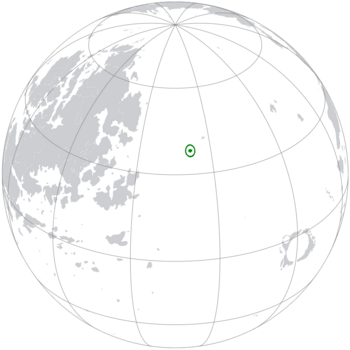Rohini
The Republic of Rohini Rohini (Oharic) | |
|---|---|
Coat of arms
| |
 Location of Rohini on Eurth | |
 Map of Rohini | |
| Capital | Vali |
| Official languages | Oharic |
| Recognised national languages | Anglish |
| Demonym(s) | Rohinese |
| Government | |
| Establishment | |
• Colony of Orioni | 1XXX |
• Republic established | 1949 |
| 2009 | |
| Area | |
• Total | 13,713 km2 (5,295 sq mi) |
| Population | |
• 2018 estimate | 1,691,876 |
• Density | 123.37/km2 (319.5/sq mi) |
| Time zone | UTC+11 |
| Date format | dd/mm/yyyy |
| Driving side | right |
The Republic of Rohini is a nation located in the North Oriental Ocean. It is an old nation, yet at the same time also very modern. The relatively unknown island in North Thalassa has always known a shaky balance between ethnic and religious groups.
Etymology
Geography
The Rohinese territory is situated in the Oriental Ocean on the northwestern area of the Thalassan continent. The Rohni or Rohini River begins in the Kagiu Hills and flows south through Vali, ending in the Oriental Ocean. Major cities include Vali (capital), Koli, Sakia, Kagiu and Ningma.
History
- The local Rohinese believe that the Empress of Orioni once came here and established a temple to worship in Amisti.
- 1912: Suppression of a revolt on Rohini island. In order to calm the situation, the empress granted a number of concessions, including the establishment of Rohinese schools, the end of conscription, and suspension of taxes for five years.
- 1949: Decolonisation of Rohini island.
- 1960s: Rohini was the scene of ethnic riots when poor Rohinese set fire to Orinese stores and businesses. The ruling nationalist NPR party subsequently launched the New Economic Policy (NEP), a kind of positive discrimination that had to give the Rohinese majority a place in the business world and gave priority to universities.
Politics
Rohini stopped being a single-party state in 1982. Political reforms during the 1990s relaxed the NPR's hold on power. During the 2000s the country faced a major challenge: for the first time since independence in 1949, the ruling NPR party was expelled from power through elections.
Political power lies with the presidency and the branches of government. Their power is based on a system of constitutional monarchy inherited from the Orinese colonizers with a proportional representation system.
- Independence from Orioni in 1949
- 1st president Mr Alcindoro (1949--1961)
- 2nd president Mrs Pasini (1961--1973)
- 3rd president Mr Polonini (1973--1985)
- Xth president Mr $Name (1985--1997)
- Xth president Mr Avery Versari (1997--2009)
- Re-admission into Orioni as semi-independent province
- 1st Governor Mr Hakim Memiri (2009--2015)
Economy
With 1,7 million inhabitants, the Republic of Rohini is not immediately a major power in North Thalassa. Until the 1980s, Rohini was a largely agricultural country with tin mines and oil. The finance industry was not yet developed. The fact that most residents spoke Oharic was a major international advantage.
But since the 1980s, under the direction of president $Name, it has been part of the economically fast-growing "Thalassan Tigers" such as Andalla, Sunset Sea Islands and Giokto. This is largely thanks to its location on the strategically very important northern archipelago between Europa and Argis. President $Name, who governed the nation between 1985 and 1997, pushed the country towards great economic development. But he tolerated criticism, neither domestic nor foreign.
The headquarters of RITZ is located in Vali. Rohini has three stations on the national train line, which connect Rohini East, Rohini West and Vali metro. The island is connected by air to major nations in Europa, Thalassa, including Orioni, Sunset Sea Islands, Andalla, Iverica and many more places.
Demographics
As per the 2018 census, Rohini had a total population of 1,691,876 of which 52% were males and 48% were females. The rate of literacy in Rohini was 75.28%.
Culture
The population is very diverse: around 60% consists of mostly ethnic Rohinese who are culturally and ethnically related to Orinese. The distinction grew during the colonial era when the Orinese took over current Rohini. In addition, Rohini has a very large Orinese minority (more than 22%) that is mainly active in the business world. A third group are immigrants from Thalassa.
Rohini is known for its cultural heritage and became a centre of education after independence. The national library has helped many researchers with its rich collection of rare books. Rohini cuisine is famous for its various seafood restaurants.
References
External links
- Project O-Mēga (22 November 2018)
This template may be deleted.

